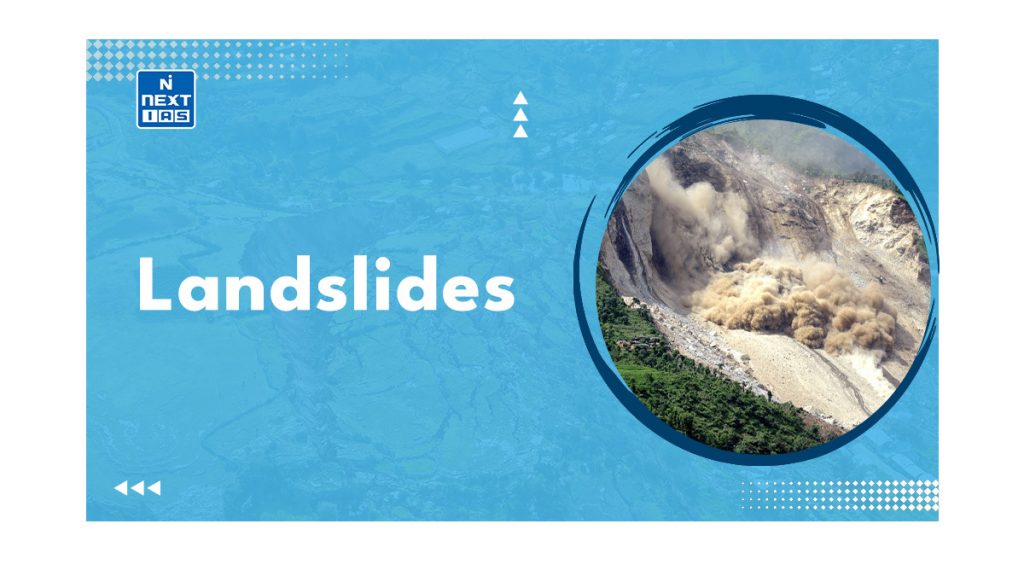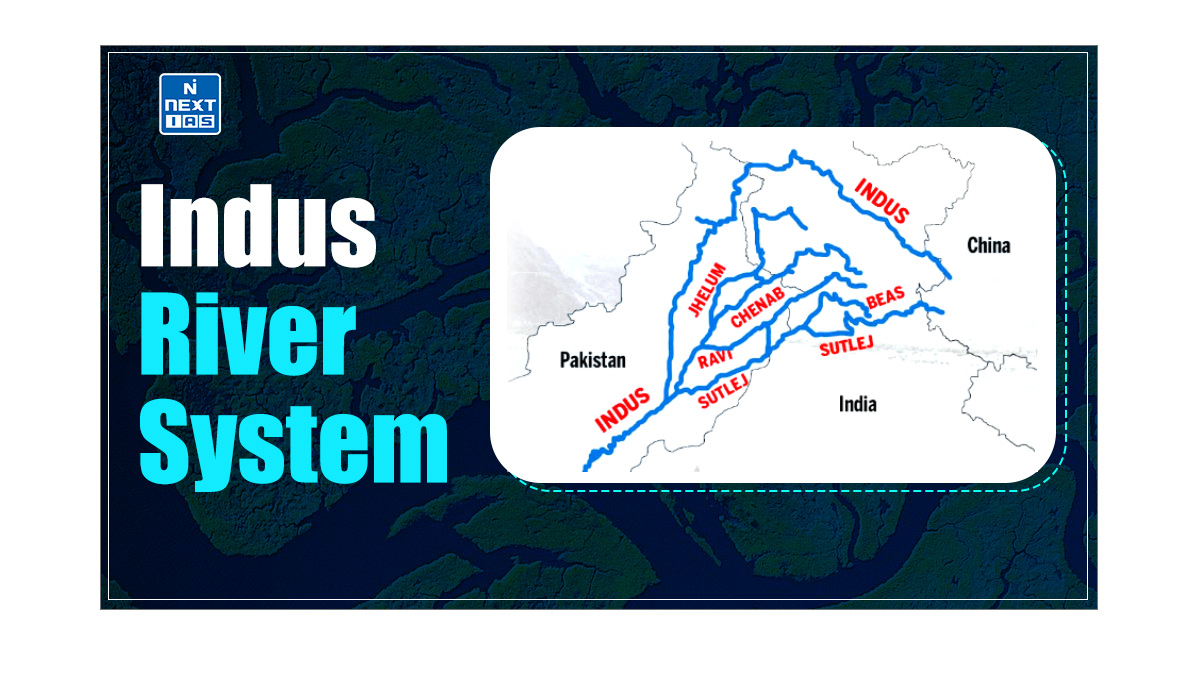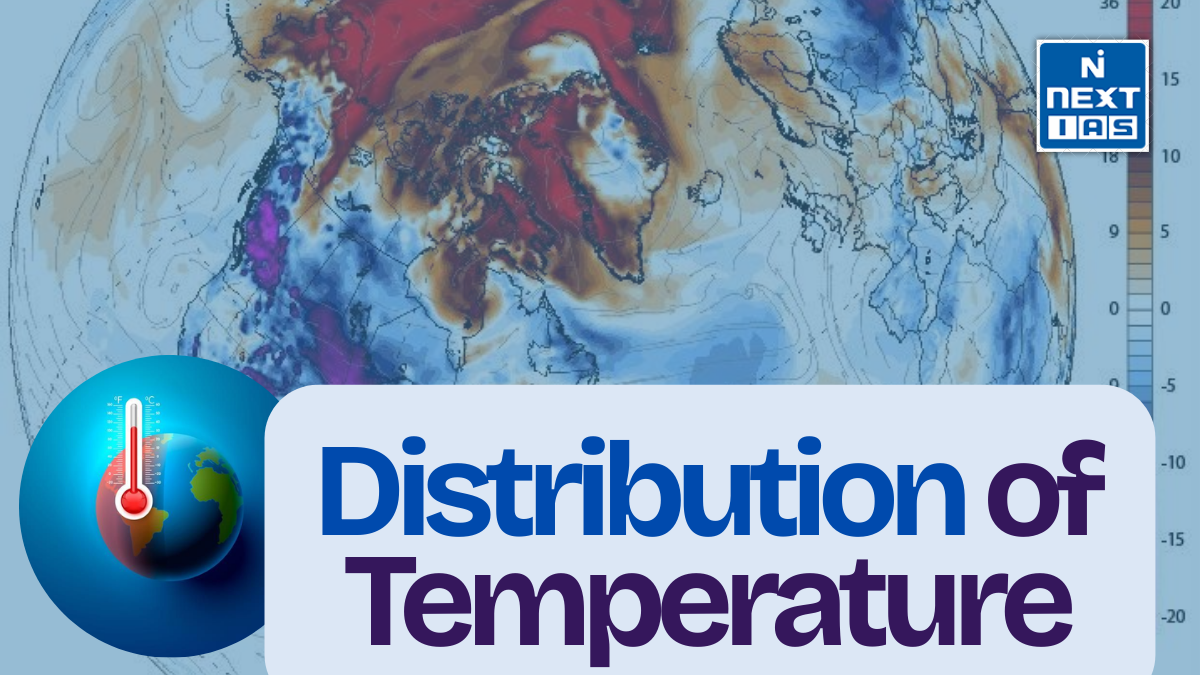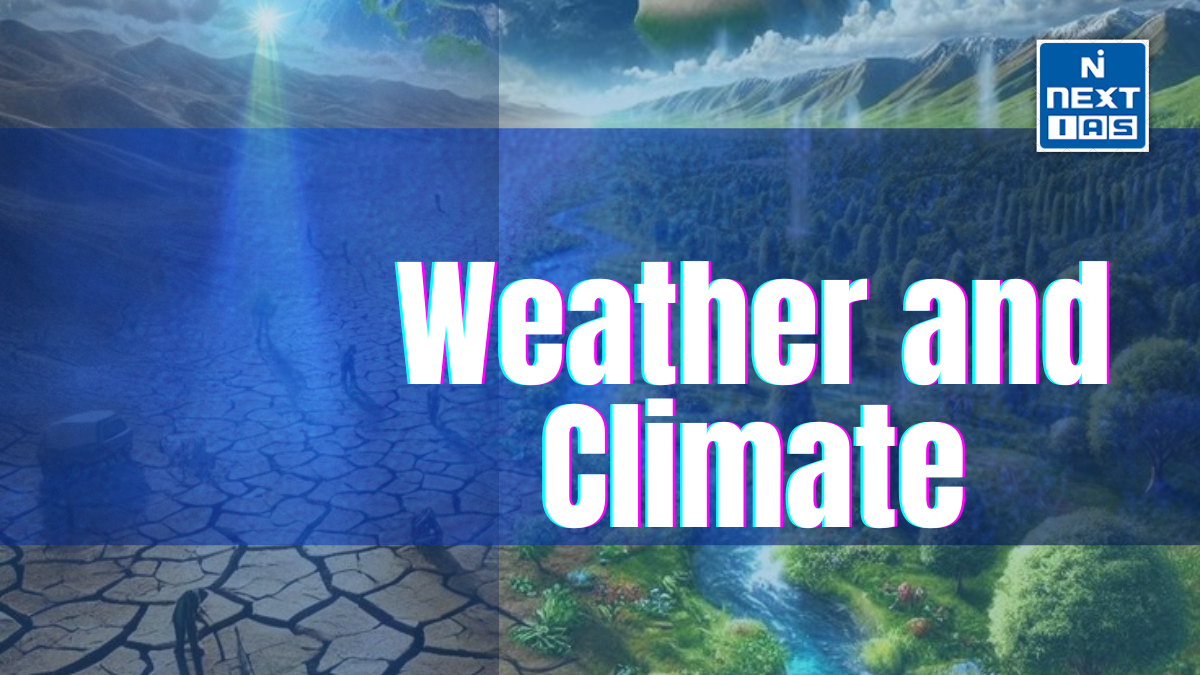
Landslides, a geological phenomenon with the potential to cause widespread devastation, are one of the most prominent disasters of concern for India. As societies expand into hilly and mountainous regions, the understanding of landslides becomes crucial for sustainable development and disaster preparedness. This article of NEXT IAS aims to explain various aspects of Landslides, including their types, causes, consequences, and mitigation strategies.
What is Landslide?
Landslides are a geological phenomenon that involves the sudden and rapid movement of a mass of rock, soil, or debris down a slope under the influence of gravity.
- Rock Flow or Rock Avalanches – a specific type of landslide or mass movement involving the flow of rock material downslope.
Characteristics of Landslide Prone Areas
Landslides, usually, occur in areas having one or more of the following characteristics:
- Steep terrain such as hilly or mountainous areas.
- Presence of joints and fissures.
- Presence of loosely-packed or weathered material
- Any area that has been burned by wildfires
- Any area that has been modified due to human activities, such as deforestation or construction
- Channels along a river-stream
- Any area where surface runoff is directed or land is heavily saturated with water.
Causes of Landslides
A variety of causes act as a trigger for a landslide. Some of the major causes of landslide can be seen under the following two heads:
Natural Causes
A myriad number of natural processes can trigger a landslide. Some prominent of them are:
- Heavy Rainfall – Heavy rainfall is one of the most common triggers of landslides. It increases pore water pressure as well as the weight of soil by making it saturated.
- Erosion – Clay and vegetation present within the soil or rock act as cohesive elements and help bind particles together. By removing these cohesive elements, erosion makes an area more prone to landslides.
- Earthquakes – intense ground shaking due to earthquakes causes instability in rocks and soils, thus triggering landslides.
- Volcanic Eruptions – Ash and debris deposited by volcanic eruptions overload slopes while the accompanied seismic activity causes instability. All these, together, trigger landslides.
Anthropogenic Causes
Several human activities can directly or indirectly influence the occurrence and magnitude of landslides. Some prominent such activities include:
- Deforestation – By holding soils as well as obstructing the flow of falling debris, vegetation cover plays an important role in preventing landslides in any area. Deforestation takes away this preventive cover and increases vulnerability to landslides.
- Encroachment in Vulnerable Terrains – Of late, humans have been encroaching in landslide-prone areas such as hilly terrains. This has led to increased construction activities in these areas and increased chances of landslides.
- Uncontrolled Excavation – Unauthorized or poorly planned excavation activities, such as mining, quarrying, etc destabilize slopes and increase the chances of landslides.
- Climate Change – Climate change caused by various anthropogenic activities has led to abrupt alterations in precipitation patterns and increased frequency of extreme weather events. All these, in turn, have increased the frequency as well as the severity of landslides.
Types of Landslides
Based on the type of movement involved, there are mainly 4 types of landslides:
- Falls – They refer to the type of landslide that involves the collapse of material from a cliff or steep slope, which then falls down the slope and collects near the base.
- Topples – Under this type of landslide, the falling mass undergoes forward rotation and movement around an axis or point at or near the base.
- Slides – Under this type of landslide, there is a distinct zone of weakness that separates the moving material from a more stable underlying material.
There are two major types of slides:
- Rotational Slide – In this type of slide, the surface of rupture is curved concavely upward and the slide movement of the falling mass is rotational about an axis that is parallel to the ground surface and transverse across the slide.
- Translational Slide – In this type of slide, the landslide mass moves along a roughly planar surface with little rotation or backward tilting.
- Flows – This type of landslide involves the movement of material down a slope in the form of a fluid.
There are different types of flows:
- Mud Flow – It involves the movement of wet material of which a majority portion is comprised of sand, silt, and clay-sized particles.
- Debris Flow – Masses such as loose soils, rocks, and organic matter combine with water to form a slurry. It, then, flows down a slope.
- Rock Flow or Rock Avalanches – a specific type of landslide or mass movement involving the flow of rock material downslope.
Effects of Landslides
Some of the key effects of can be seen as follows:
- Loss of human and animal lives.
- Damage to infrastructure and properties such as homes, roads, etc.
- They can bury or wash away agricultural land, thus affecting agriculture.
- The aftermath of landslides may mean the displacement of local communities.
- Landslides, often, block transportation routes such as roads. This, then, has its own repercussions.
- The movement of huge mass during landslides can alter the natural landscape of a region. This, in turn, affects the ecosystem, water courses, etc.
Landslide Prone Areas in India
ISRO has recently released the Landslide Atlas of India. As per this atlas, some of the prominent statistics regarding landslides in India are as follows:
- India is among the top five landslide-prone countries in the world.
- Excluding snow-covered areas, around 12.6 percent of India’s geographical land area is prone to landslides.
- A rough break-up of reported landslides in India is as follows:
- About 66.5 percent from the North-Western Himalayas
- About 18.8 percent from the North-Eastern Himalayas
- About 14.7 percent from the Western Ghats.
As per the Landslide Atlas of India, major landslide prone areas in India are as follows:
- The Northeastern Region (comprises about 50 percent of the total landslide prone areas in India)
- Areas of Uttarakhand, Himachal Pradesh, and Jammu & Kashmir lying along the Himalayas.
- Areas of Maharashtra, Goa, Karnataka, Kerala, and Tamil Nadu lying along the Western Ghats.
- The Araku region in Andhra Pradesh along the Eastern Ghats.
Measures Taken in India
Some of the prominent measures taken for proper management of landslides in India are as follows:
- The Disaster Management Act, of 2005 provides a comprehensive legal and institutional framework for the management of various disasters including landslides.
- The National Landslide Risk Management Strategy (2019) covers all aspects of landslide disaster risk reduction and management, such as hazard mapping, monitoring, and early warning systems.
- The National Disaster Management Authority (NDMA) has issued Guidelines on Landslide Hazard Management (2009) that outline the steps that should be taken to reduce the risk of landslides.
- The National Institute of Disaster Management (NIDM) has been providing capacity building and other support to various national and state-level disaster management authorities.
- Efforts have been made towards better prediction of weather. E.g. Ensemble Prediction System. This will help predict disasters like landslides.
Suggested Measures
- Promotion of terrace farming can help reduce landslide risks.
- Afforestation and construction of bunds to reduce the flow of falling materials.
- Retaining walls can be built on mountain slopes to stop the falling materials coming down.
- As suggested by the 10th FYP, mitigation measures should be built into the development process itself.
- A more granular Hazard Mapping to have accurate knowledge of prone areas.
- Traditional knowledge of the local community should be used to tackle such kinds of disasters.
- Education and training can help ensure the preparedness of the disaster management authorities as well as the local community.
Landslides as one of the prominent disasters concerning India have far-reaching consequences. As societies continue to expand into vulnerable regions, a proactive approach to landslide prevention and mitigation becomes imperative. The measures suggested as above can help in this direction.
Frequently Asked Questions (FAQs)
What are the causes of landslides?
Landslides are caused by natural factors such as heavy rainfall, earthquakes, volcanic activity, and erosion, as well as human activities like deforestation, unplanned construction, and improper agricultural practices.
Where was the recent landslide in India? Describe the mitigation mechanism of landslides.
The recent landslide in India occurred in Gaurikund, Uttarakhand, in July 2024, triggered by heavy rainfall.
Mitigation Mechanisms:
– Structural Measures: Retaining walls, proper drainage, and slope stabilization.
– Non-Structural Measures: Early warning systems, hazard mapping, and land-use planning.
– Community Measures: Awareness, disaster preparedness, and evacuation protocols.






